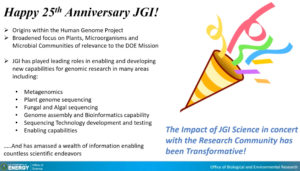As part of the JGI’s 25th anniversary celebration, the 2022 Annual Meeting featured speakers who shared a look back at the JGI’s history, from its beginnings in the sequencing for the Human Genome Project out to the future of the institution. Their talks shed light on how the JGI was established, all that it has contributed, and what they’re excited about in JGI’s future.
Find recordings and recaps of these talks below, starting with Ari Patrinos. Jump to Todd Anderson’s talk here, or jump to Dan Drell’s talk here.
The Genomics Arms Race
Ari Patrinos, Former Director of DOE’s Office of Biological and Environmental Research
“There are two kinds of scientific revolutions,” Ari Patrinos opened with this quote from Thomas Kuhn in his 25th Anniversary presentation. “Those driven by new tools and those driven by new concepts.” Patrinos went on to explain that the JGI’s very first project — the revolutionary work of the human genome project, which spanned nearly two decades, was filled with ups and downs, challenges and triumphs, and a lot of hard work along the way.
In this historical perspective of the human genome project, Patrinos walked the audience through the initial conversations between Los Alamos National Lab and the Department of Energy (DOE) colleagues. “At that time (1986) 98% of the human genome was thought to be junk DNA, so there was quite a bit of resistance to use resources to sequence it,” Patrinos said.
After many more meetings and letters of persuasion, Patrinos and his colleagues were able to convince the DOE and National Institute of Health that this effort would prove invaluable. By the mid-1990s, the sequencing efforts expanded beyond LANL to include resources from Lawrence Livermore and Lawrence Berkeley National Labs. Patrinos shared vivid memories in his presentation of the times that he brought together the three lab directors to work through the project. They faced something of a genomic arms race as they recognized the private industry’s interest in simultaneously sequencing the human genome. (For more about the JGI’s role in the Human Genome Project, check out the JGI’s origin story.)
By 2000, a drafted human genome was produced by a joint effort between public and private sectors and it is still seen today as a massive feat in science and collaboration. In closing his presentation, Patrinos shared nine lessons learned from his time involved in the project, mostly focused around how to best work together to achieve great success. “For the most difficult challenges, no one agency has enough to go for it alone,” he said.
A Larger Story; a Hardworking Team
Todd Anderson, Director of the Biological Systems Science Division at DOE Office of Biological and Environmental Research
Todd Anderson currently works to support understanding of plants, microbes and environmental communities that have relevance for DOE’s bioenergy and environmental goals. While he’s very familiar with the JGI’s research portfolio, he admitted that boiling that portfolio’s impact down into a succinct message was quite a challenge.
“The default idea was to put together a ‘Best of the Best’ genome sequence list, which I found utterly frustrating and impossible to do,” Anderson said.
All of the JGI’s accomplishments contribute to the full story of the institution’s impact, Anderson explained. As an illustration of this, he noted the new 25th anniversary mural that local Bay Area artist Nigel Sussman recently finished at the Integrative Genomics Building, the JGI’s home at Berkeley Lab. Like the mural, the JGI’s accomplishments over 25 years span a broad, colorful range.
Behind every genomic sequence, Anderson said, there’s both a larger story and a hardworking team. He highlighted several important projects the JGI has worked on, from the myriad of omics analyses for understanding gene expression in plants and the environment, to the JGI’s forging new collaborations with the FICUS program, through which researchers can access multiple DOE facilities with a single proposal.
From the vantage point of JGI’s 25 years fueling discovery, Anderson looked toward the JGI’s next decades of science with enthusiasm. He pointed toward many more years of enabling clean energy and renewable production — and congratulated JGI on the anniversary.
“This is a remarkable milestone, but perhaps not so unexpected given JGI’s remarkable ability to adapt to a changing scientific and technological landscape.”
Scientific Impact Takes Time
Dan Drell, Former DOE program manager for the Joint Genome Institute
Dan Drell, like Ari Patrinos, was around for the JGI’s inception as part of the Human Genome Project. He managed a small but important part of that program — looking at ethical, legal and social affairs — before stepping into his role as program manager in 2006 when the JGI transitioned from human to microbial genetics. Drell held the role until he retired in 2018.
“While I never said this out loud,” Drell said, speaking to users and staff at the JGI’s 2022 User Meeting, “…I think I had the easiest job in the office.”
The crowd chuckled as Drell continued on, ticking off a list of JGI staff names “and many, many more who collectively put fewer demands on me than any other user facility program manager. It’s easy to look good when you have great people doing a great job in anticipating the challenges and addressing the problems early when they’re small, easier to deal with and before they grow into big headaches.”
He reminisced over the building of the Integrative Genomics Building, the JGI’s home at Berkeley Lab, as further testament to the collective impact of motivated and dedicated employees: “Nigel [Mouncey] and his team have continued that excellence.”
Drell said that, during his time as program manager, he rarely received calls that were critical of the JGI’s work. Those which he received tended to be from individuals whose projects were not accepted. As for feedback from those actually working with the JGI, Drell said that whenever encountering JGI users, he was greeted with praise for the how hard staff worked to help users achieve their project goals.
“For [DOE’s Biological and Environmental Research] and the communities of science you serve and enable, it’s really the science. With very rare exceptions, scientific impact takes time.”
Drell pointed to difficulties pulling out quantitative and predictive measurements that reflect the potential for long-term impact, relying instead on anecdotes that can be hard to generalize.
“The best anecdotes to me have always seemed to me to have the element of wonder,” he said, referencing the unpredictable milestones of Hamilton Smith’s discovery of restriction enzymes in the 1960s, as well as Jill Banfield and Jennifer Doudna’s work leading to CRISPR-Cas9 — Neither discovery could have been planned or budgeted for, he pointed out.
There are numbers out there, Drell noted, including the figure 30-million fold: How much JGI’s productivity has increased since 1997. What took the JGI one year to do in 1997, now takes roughly one second.
“It isn’t just the generation of vast troves of data, it’s the new areas of scientific possibility that these accomplishments open up … What the JGI has done for so many years is to, ‘boldly go where no one has gone before’ and quite frankly that’s the best characterization of your science that I can come up with.”


